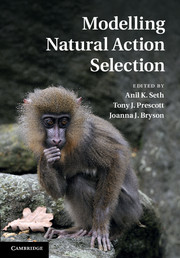Book contents
- Frontmatter
- Contents
- Foreword
- Preface
- Contributors
- 1 General introduction
- Part I Rational and optimal decision making
- Part II Computational neuroscience models
- Part III Action selection in social contexts
- 18 Introduction to Part III: action selection in social contexts
- 19 Agent-based models as scientific methodology: a case study analysing the DomWorld theory of primate social structure and female dominance
- 20 An agent-based model of group decision making in baboons
- 21 Endogenous birth and death of political parties in dynamic party competition
- 22 On optimal decision making in brains and social insect colonies
- 23 State-dependent foraging rules for social animals in selfish herds
- Index
- Plate section
- References
21 - Endogenous birth and death of political parties in dynamic party competition
from Part III - Action selection in social contexts
Published online by Cambridge University Press: 05 November 2011
- Frontmatter
- Contents
- Foreword
- Preface
- Contributors
- 1 General introduction
- Part I Rational and optimal decision making
- Part II Computational neuroscience models
- Part III Action selection in social contexts
- 18 Introduction to Part III: action selection in social contexts
- 19 Agent-based models as scientific methodology: a case study analysing the DomWorld theory of primate social structure and female dominance
- 20 An agent-based model of group decision making in baboons
- 21 Endogenous birth and death of political parties in dynamic party competition
- 22 On optimal decision making in brains and social insect colonies
- 23 State-dependent foraging rules for social animals in selfish herds
- Index
- Plate section
- References
Summary
‘Spatial’ models of political competition
People who talk about politics talk sooner or later about positions of political actors, be these citizens, voters, activists, or politicians. It is hard to have a serious discussion about the substance of real politics without referring to where key actors stand on important matters. Position implies distance (between two positions); distance implies movement; movement involves direction and can only be described relative to some benchmark. Indeed, it is difficult to analyse real political competition without using positional language and reasoning. This is why the spatial model is one of the ‘workhorse’ models of political science (Cox, 2001).
Spatial models of party competition typically involve two species of agent: voters and politicians. Voters have preferences about political outcomes. Politicians compete for voters’ support by offering policy packages, in essence promised outcomes that appeal to these preferences. Voters’ preferences are typically assumed to be single-peaked over the set of potential outcomes. This implies an ideal point for each voter, describing the most-preferred outcome. Less-preferred outcomes are described as points in some cognitive space that are increasingly far from this ideal. Although not a logical necessity, many models of party competition assume the set of voter ideal points to be both exogenously given and mapped into a common space. Basis vectors of real-world political spaces are typically interpreted as policy dimensions. Examples of such policy dimensions include economic left-right, social liberal-conservative, and foreign policy hawk-dove. In the ‘proximity-voting’ models that are common characterisations of voting in large electorates, each voter is assumed to support the politician offering the policy package closest to their ideal point. More complex assumptions may be made about strategic behaviour by voters. While these may be appropriate in small voting bodies where the voter has some realistic rational expectation that a single vote will affect the outcome, we do not consider these assumptions realistic in relation to voting in very large electorates, which is the setting we concern ourselves with here. Hinich and Munger provide an accessible introduction to spatial models of party competition (Hinich and Munger, 1994, 1997). Austen-Smith and Banks provide a comprehensive technical overview (2000, 2005).
- Type
- Chapter
- Information
- Modelling Natural Action Selection , pp. 477 - 499Publisher: Cambridge University PressPrint publication year: 2011

